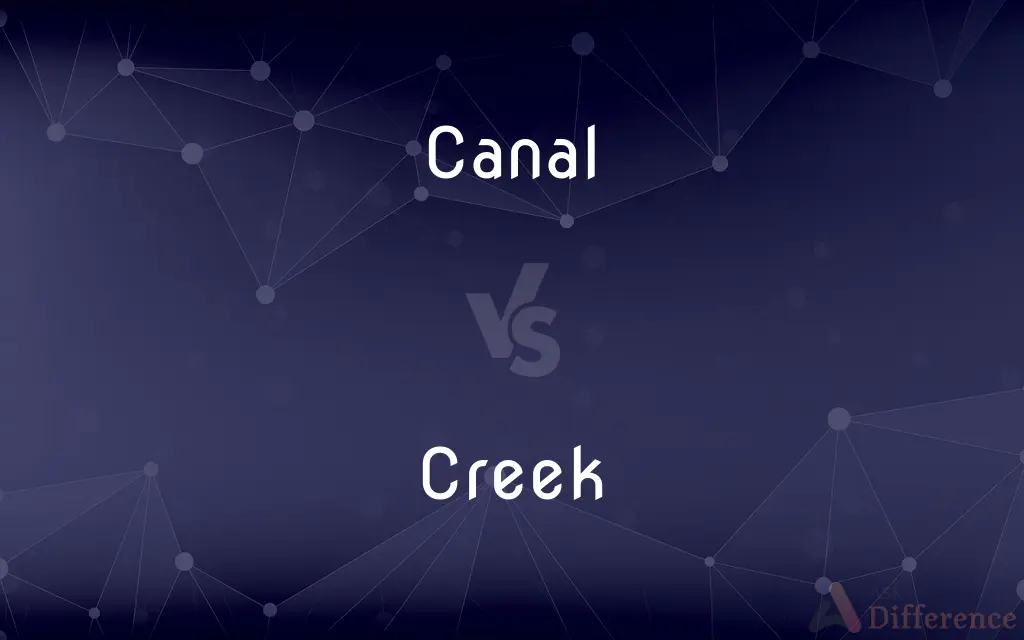Canal vs. Creek — What's the Difference?
By Maham Liaqat & Urooj Arif — Updated on March 30, 2024
Canals are man-made waterways constructed for navigation, irrigation, or drainage, while creeks are small, natural streams, often tributaries of rivers or lakes.

Difference Between Canal and Creek
Table of Contents
ADVERTISEMENT
Key Differences
Canals are engineered structures, designed and built to facilitate water transport, manage water resources, or aid in drainage and flood control. These waterways are often critical for commercial navigation, connecting seas, lakes, and rivers to enhance trade and transportation. Creeks, on the other hand, are naturally occurring, smaller bodies of flowing water. They typically feed into larger streams or rivers and are characterized by their natural, often winding courses through the landscape.
The construction of canals involves significant planning, engineering, and labor to create a waterway that meets specific human needs, such as irrigation for agriculture, facilitating ship movement, or providing urban water supply. Creeks form through natural processes of erosion and rainfall runoff, carving their paths through the earth without human intervention. Their presence and course are determined by the natural topography and hydrology of an area.
Canals can significantly alter the natural landscape and ecosystem, sometimes connecting bodies of water that were previously unlinked, which can have profound ecological impacts. Conversely, creeks are part of the natural watershed, contributing to local biodiversity and serving as habitats for various species. They play crucial roles in the ecological balance by connecting different parts of a watershed.
In terms of usage, canals are often associated with human activities such as transportation of goods and people, agricultural irrigation, and recreational activities like boating and fishing in controlled environments. Creeks, while they may also be used for recreation, are more often valued for their ecological roles, including supporting wildlife, recharging groundwater, and filtering pollutants from runoff.
Despite their differences, both canals and creeks are vital waterways that serve distinct purposes. Canals reflect human ingenuity in managing water resources for specific uses, whereas creeks are natural elements of the landscape that contribute to the ecological health of the environment.
ADVERTISEMENT
Comparison Chart
Origin
Man-made
Natural
Purpose
Navigation, irrigation, drainage
Natural flow, ecosystem support
Construction
Requires significant engineering and labor
Formed by natural processes
Environmental Impact
Alters landscapes, can connect separate waters
Part of natural watershed, supports biodiversity
Usage
Commercial navigation, irrigation, recreation
Ecological health, recreation
Compare with Definitions
Canal
A man-made waterway for transportation and irrigation.
The Panama Canal connects the Atlantic and Pacific Oceans.
Creek
A natural, small stream or tributary.
The creek behind my house flows into the river.
Canal
Engineered for controlled water management.
The irrigation canals sustain agriculture in arid regions.
Creek
Forms naturally, often winding.
Creeks carve through forests and valleys.
Canal
Reflect human modification of the landscape.
Urban canals can create waterfront living spaces.
Creek
Part of the natural watershed.
Creeks help recharge groundwater supplies.
Canal
Can cross geographical barriers.
Canals in Venice serve as streets for boats.
Creek
Can vary in size with rainfall.
The creek swells during the rainy season.
Canal
Often straight, following a direct path.
The Suez Canal is a critical maritime shortcut.
Creek
Supports local ecosystems.
The creek is home to various fish species.
Canal
Canals are waterway channels, or artificial waterways, for water conveyance, or for servicing water transport vehicles. They carry free surface flow under atmospheric pressure, and can be thought of as artificial rivers.
Creek
A member of a Native American people formerly inhabiting eastern Alabama, southwest Georgia, and northwest Florida and now located in central Oklahoma and southern Alabama. The Creek were removed to Indian Territory in the 1830s.
Canal
An artificial waterway constructed to allow the passage of boats or ships inland or to convey water for irrigation
The Oxford Canal
They travelled on by canal
Creek
The Muskogean language of the Creek.
Canal
A tubular duct in a plant or animal, serving to convey or contain food, liquid, or air
The ear canal
Creek
A Native American confederacy made up of the Creek and various smaller southeast tribes.
Canal
Any of a number of linear markings formerly reported as seen by telescope on the planet Mars.
Creek
A member of this confederacy. In all senses also called Muskogee1.
Canal
An artificial waterway or artificially improved river used for travel, shipping, or irrigation.
Creek
A small stream, often a shallow or intermittent tributary to a river. Also called regionally branch, brook1, kill2, run.
Canal
(Anatomy) A tube, duct, or passageway.
Creek
A channel or stream running through a salt marsh
Tidal creeks teeming with shore wildlife.
Canal
(Astronomy) One of the faint, hazy markings resembling straight lines on early telescopic images of the surface of Mars.
Creek
Chiefly British A small inlet in a shoreline, extending farther inland than a cove.
Canal
To dig an artificial waterway through
Canal an isthmus.
Creek
(British) A small inlet or bay, often saltwater, narrower and extending farther into the land than a cove; a recess in the shore of the sea, or of a river; the inner part of a port that is used as a dock for small boats.
Canal
To provide with an artificial waterway or waterways.
Creek
A stream of water (often freshwater) smaller than a river and larger than a brook; in Australia, also used of river-sized bodies of water.
Canal
An artificial waterway or artificially improved river used for travel, shipping, or irrigation.
Creek
Any turn or winding.
Canal
(anatomy) A tubular channel within the body.
Creek
A small inlet or bay, narrower and extending further into the land than a cove; a recess in the shore of the sea, or of a river.
Each creek and cavern of the dangerous shore.
They discovered a certain creek, with a shore.
Canal
(astronomy) One of the faint, hazy markings resembling straight lines on early telescopic images of the surface of Mars; see Martian canals
Creek
A stream of water smaller than a river and larger than a brook.
Lesser streams and rivulets are denominated creeks.
Canal
To dig an artificial waterway in or to (a place), especially for drainage
Creek
Any turn or winding.
The passages of alleys, creeks, and narrow lands.
Canal
To travel along a canal by boat
Creek
A natural stream of water smaller than a river (and often a tributary of a river);
The creek dried up every summer
Canal
An artificial channel filled with water and designed for navigation, or for irrigating land, etc.
Creek
Any member of the Creek Confederacy (especially the Muskogee) formerly living in Georgia and Alabama but now chiefly in Oklahoma
Canal
A tube or duct; as, the alimentary canal; the semicircular canals of the ear.
Canal
A long and relatively narrow arm of the sea, approximately uniform in width; - used chiefly in proper names; as, Portland Canal; Lynn Canal.
Canal
(astronomy) an indistinct surface feature of Mars once thought to be a system of channels; they are now believed to be an optical illusion
Canal
A bodily passage or tube lined with epithelial cells and conveying a secretion or other substance;
The tear duct was obstructed
The alimentary canal
Poison is released through a channel in the snake's fangs
Canal
Long and narrow strip of water made for boats or for irrigation
Canal
Provide (a city) with a canal
Common Curiosities
Can canals be found in urban areas?
Yes, canals are often constructed in urban areas for water supply, drainage, or as scenic and recreational spaces.
What is the main difference between a canal and a creek?
Canals are man-made waterways for specific human purposes, while creeks are small, natural streams.
What ecological roles do creeks play?
Creeks contribute to local biodiversity, support wildlife, recharge groundwater, and filter runoff pollutants.
How does the water flow in canals compared to creeks?
Canal water flow is often controlled through locks and gates, while creek flow follows natural topography.
Are creeks always smaller than rivers?
Generally, yes. Creeks are smaller, often tributary streams that feed into larger rivers or lakes.
How do humans benefit from canals?
Humans use canals for transportation, irrigation, water supply, and recreational activities.
Can the construction of a canal impact local ecosystems?
Yes, constructing a canal can significantly alter local ecosystems and hydrology, sometimes with negative environmental impacts.
Do creeks contribute to the water cycle?
Yes, creeks play an integral role in the water cycle by connecting different parts of a watershed.
How are canals maintained?
Canals require regular maintenance, including dredging, repair of locks and gates, and vegetation control.
Are there any famous canals known worldwide?
Yes, the Suez Canal and the Panama Canal are among the most famous canals, crucial for global maritime trade.
Are creeks navigable?
Most creeks are too small and shallow for commercial navigation but may be used for small boats or recreational purposes.
Why are canals important for agriculture?
Canals provide essential irrigation water, transforming arid and semi-arid lands into productive agricultural areas.
Can the course of a creek change naturally?
Yes, the course of a creek can change due to natural processes like erosion, sediment deposition, and flooding.
What challenges do creeks face?
Creeks face challenges such as pollution, habitat destruction, and altered flow due to human activities.
Can creeks become polluted?
Yes, creeks can become polluted from runoff, affecting water quality and ecosystem health.
Share Your Discovery

Previous Comparison
Vassal vs. Knight
Next Comparison
Head vs. PusherAuthor Spotlight
Written by
Maham LiaqatCo-written by
Urooj ArifUrooj is a skilled content writer at Ask Difference, known for her exceptional ability to simplify complex topics into engaging and informative content. With a passion for research and a flair for clear, concise writing, she consistently delivers articles that resonate with our diverse audience.
















































